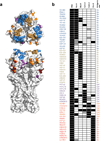Defining B cell immunodominance to viruses
- PMID: 28192417
- PMCID: PMC5360521
- DOI: 10.1038/ni.3680
Defining B cell immunodominance to viruses
Abstract
Immunodominance (ID) defines the hierarchical immune response to competing antigens in complex immunogens. Little is known regarding B cell and antibody ID despite its importance in immunity to viruses and other pathogens. We show that B cells and serum antibodies from inbred mice demonstrate a reproducible ID hierarchy to the five major antigenic sites in the influenza A virus hemagglutinin globular domain. The hierarchy changed as the immune response progressed, and it was dependent on antigen formulation and delivery. Passive antibody transfer and sequential infection experiments demonstrated 'original antigenic suppression', a phenomenon in which antibodies suppress memory responses to the priming antigenic site. Our study provides a template for attaining deeper understanding of antibody ID to viruses and other complex immunogens.
Figures







Comment in
-
Quantifying the shifting landscape of B cell immunodominance.Nat Immunol. 2017 Mar 22;18(4):367-368. doi: 10.1038/ni.3695. Nat Immunol. 2017. PMID: 28323262 No abstract available.
References
-
- Yewdell JW. Confronting complexity: real-world immunodominance in antiviral CD8+ T cell responses. Immunity. 2006;25:533–543. - PubMed
-
- Krammer F, Palese P. Advances in the development of influenza virus vaccines. Nat Rev Drug Discov. 2015;14:167–182. - PubMed
-
- Wheatley AK, Kent SJ. Prospects for antibody-based universal influenza vaccines in the context of widespread pre-existing immunity. Expert Rev Vaccines. 2015;14:1227–1239. - PubMed
METHODS ONLY REFERENCES
-
- Yewdell JW, Gerhard W. Antigenic characterization of viruses by monoclonal antibodies. Annual Review of Microbiology. 1981;35:185–206. - PubMed
-
- Pieri L, Sassoli C, Romagnoli P, Domenici L. Use of periodate-lysine-paraformaldehyde for the fixation of multiple antigens in human skin biopsies. Eur J Histochem. 2002;46:365–375. - PubMed
Publication types
MeSH terms
Substances
Grants and funding
LinkOut - more resources
Full Text Sources
Other Literature Sources
Medical

